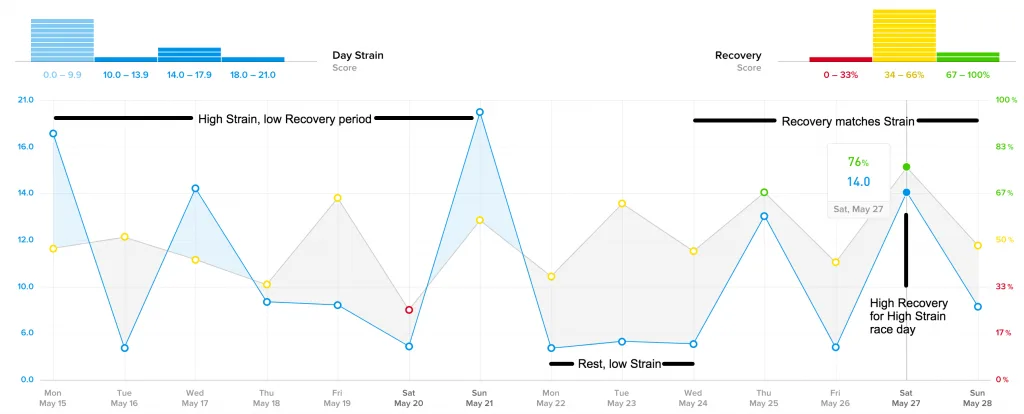Topics
- Article
“Why I Use WHOOP” By 26-Year-Old Heart Attack Survivor, Cyclist Nick Weber

Nick Weber’s life was turned upside down when he suffered a major heart attack while riding his bike at age 22. Doctors found a tear in the wall of his coronary artery, the cause of which still remains a mystery. Nick has made it his goal to prove that he, and other young heart attack survivors like him, can still live a physically active and competitive lifestyle. Nick recently reached out to WHOOP with a desire to share what our product has done for him. Here is his story.
There is nothing quite like the feeling of freedom you get from flying downhill on a bike, or pushing your body to its limit in a sprint to the finish. Cycling allows me to clear my mind and feed my competitive spirit, but the training can be extremely demanding.
Not long ago, a close friend and training partner, Eric Torello, introduced me to WHOOP. Since then, I have been able to eliminate the guesswork in assessing what my body can handle.
WHOOP is a small lightweight band that tracks your biometrics and connects to a mobile app. Unlike similar products, it takes into consideration the amount of sleep you got the night before and incorporates how well your body is able to recover through 24/7 performance monitoring. With WHOOP, I have not only become a better athlete, but also a more effective tenant of my body’s well being.

I enjoy being competitive in group rides, which due to my hectic schedule, is what I consider my “races.” I am always looking at how I can keep improving for the next weekend’s competition. When it comes to getting a positive result, preparation is essential. The morning Recovery metric that WHOOP provides has become invaluable to my preparation and strategy for these rides.
If I wake up with a low Recovery before a competition, I will focus on sticking in the middle of the peloton (a group of cyclists riding close together) in order to save my energy by drafting behind other riders. On the other hand, if my WHOOP Strap tells me I am well Recovered, I will put in harder efforts throughout the ride because I know that my body can take on that Strain.
Strain has always been a major topic of conversation in training for a sport like cycling. What is normally a beneficial amount of training load over a period of time can quickly become detrimental when you are not able to see the warning signs of your body’s fatigue or overtraining. WHOOP gives me early indicators when I am taking on too much Strain and need to back off.
In the screenshot of my WHOOP data below, you can see that at one point I was putting in a lot of hours training and became not only physically fatigued, but mentally exhausted as well. My WHOOP data confirmed what I was feeling and convinced me to take a short break from the bike to rest and recuperate. WHOOP saved me from completely overtraining, which could have taken weeks or months to come back from.

By sharing my WHOOP data with my coach Tony Baca, a pro cyclist for Elbowz Pro Racing, we are able to make necessary changes to my training plan in order to get the most of every workout. We schedule my training days in advance, but sometimes work calls at 10 pm on a Friday night. After 4 hours of sleep, (and with a low Recovery) the 5-hour ride planned for Saturday gets adjusted to take into account what WHOOP is telling me about my body’s readiness to perform.
I am about to start graduate school at Dartmouth College in the fall, where I will be studying healthcare and working with faculty and alumni on my startup company. This will no doubt add many other factors affecting my daily Strain, aside from just riding my bike.
Balancing these everyday stressors will be easier to do with WHOOP. I expect it to be quite useful for things like determining when I’ve reached my limit for the night studying in the library, and knowing when I need to get to bed to perform as a student the next day.

Four years ago I suffered a heart incident. I am now much more cognizant of how I’m feeling and likely listen to my body more than most other athletes.
Because of my incident, I pay very close attention to what my WHOOP tells me. Before using the WHOOP Strap, it was often difficult to know when I needed to take a day off. I am thankful I can rely on software that uses variables such as resting heart rate and heart rate variability to help determine what I should do each day.
The daily user input questionnaire on the WHOOP app is also beneficial in spotting trends that may hinder my Recovery for the next day. I began to see patterns of low Recoveries after staying up too late working, eating poorly at times, and interestingly, when looking at my cell phone before bed. While I cannot say that I am perfect at curbing these habits, WHOOP has heightened my awareness and allowed me to do a much better job at improving upon them.
I am grateful to have a device that gives me such in-depth information and guidance for both my training and overall health. WHOOP is not just for pro athletes and elite performers. It’s also an ideal tool for people like me who have many other priorities in their lives but still want to be the best they can be in their sport with the time they are able to commit to it.
RELATED: Recovery Tips from Leading WHOOP Users
Have a WHOOP story you’d like to share? Email TheLocker@whoop.com. And make sure to check out @whoop on Instagram, Twitter and Facebook.